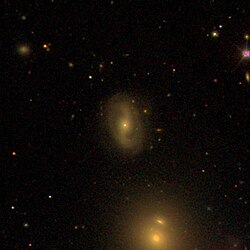NGC 998
Appearance
| NGC 998 | |
|---|---|
 SDSSimage of NGC 998 | |
| Observation data (J2000epoch) | |
| Constellation | Cetus |
| Right ascension | 02h37m16.50891s[1] |
| Declination | +07° 20′ 08.7169″[1] |
| Redshift | 0.02184[2] |
| Heliocentric radial velocity | 6476 km/s[2] |
| Distance | 303.7 ± 21.4Mly(93.11 ± 6.56Mpc)[3] |
| Apparent magnitude(B) | 14.6[2] |
| Absolute magnitude(V) | -23.46 +/- 0.51[2] |
| Characteristics | |
| Type | S?[2] |
| Other designations | |
| MCG+01-07-015,PGC9934[2] | |
NGC 998is aspiral galaxyin theconstellation Cetus.It is estimated to be 294 millionlight yearsfrom theMilky Wayand has adiameterof approximately 90,000 ly. Together with NGC 997, it forms agravitationally boundpair of galaxies. NGC 998 was discovered byastronomerAlbert Marthon 10 November 1863 using a 48-inch telescope.[4][5][6]
See also
[edit]References
[edit]- ^abBrown, A. G. A.;et al. (Gaia collaboration) (August 2018)."GaiaData Release 2: Summary of the contents and survey properties ".Astronomy & Astrophysics.616.A1.arXiv:1804.09365.Bibcode:2018A&A...616A...1G.doi:10.1051/0004-6361/201833051.
- ^abcdef"NGC 998".SIMBAD.Centre de données astronomiques de Strasbourg.Retrieved2020-06-03.
- ^"Results for object NGC 0998 (NGC 998)".NASA/IPAC Extragalactic Database.California Institute of Technology.Retrieved2020-06-03.
- ^"Revised NGC Data for NGC 998".spider.seds.org.Retrieved2020-03-24.
- ^"Your NED Search Results".ned.ipac.caltech.edu.Retrieved2020-03-24.
- ^Ford, Dominic."The galaxy NGC 998 - In-The-Sky.org".in-the-sky.org.Retrieved2020-03-24.
External links
[edit] Media related toNGC 998at Wikimedia Commons
Media related toNGC 998at Wikimedia Commons
